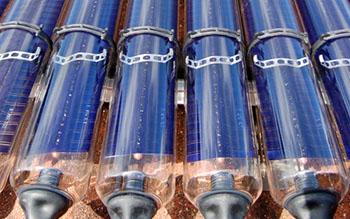Solar water heating efficiency
Generally, a solar water heating system can produce between 40-70% of the hot water needed by an average family of 4 annually. Exactly how much hot water you will benefit from is difficult to estimate, however, as there are a number of factors to consider:How much sunlight is available? In the sunnier UK months between April - September your collectors will absorb more heat from the sun and therefore generate more hot water. On cloudy days the system will not produce as much hot water.How much hot water does your family use? Obviously the busier your household the higher demand you will be placing on the system and the more likely it is you will need to supplement your supply with a boiler or immersion heater.Are you prepared to adapt your routine to suit the system? For example, taking showers in the evening when the hot water supply is at its highest is a great way to make the most of the hot water available.The capacity of your hot water cylinder will impact how much hot water you can store. If the cylinder can only hold one day's worth of hot water, more than one cloudy day will mean you need to supplement with an immersion heater or boiler.If your heating and hot water are not set up with separate controls, when the heating is on your hot water supply may be reduced.It's important to ensure that both your cylinder and pipework are adequately insulated to prevent heat loss.Keep in mind that you may not need the system to heat water to the highest possible temperature at all times. You can reduce the need for backup water heating by lowering the temperature of the water.
Types of solar thermal panels
There are 2 types of solar thermal collector: flat plate or evacuated tubes.

Flat Plate Collectors:
Flat plate collectors look more like traditional solar panels. They have a flat, glazed, dark-surfaced absorber plate which contains metal tubing. The plate covering the tubing, which is normally copper or aluminium, absorbs the solar energy and the casing stops heat from escaping from it. A fluid is constantly run through the tubing which is heated up by the solar power captured from the sun.

Evacuated Tube Collectors:
Evacuated tube collectors have a very different look. The panel is a collection of glass tubes in a parallel row which have an absorber insulated by a partial vacuum. They are generally more expensive than flat plate collectors but provide an alternative aesthetic option and are argued to be the more efficient option.
There are two different types of evacuated tube solar panels:
Direct Flow, where the fluid flowing in the absorber also flows through the pipes to the hot water cylinder.
Heat Pipes which have fluid in them that evaporates at a low temperature. When the fluid evaporates it rises up in the tube and condenses, transferring the heat it was carrying and the latent heat of condensation into the pipes into the hot water cylinder. The fluid then runs back down the tube again ready to be reheated.
Best solar thermal manufacturers
We have listed some of the best solar thermal manufacturers on the market here, but you can find more information in our Best Solar Thermal Panels article.
| Manufacturer | Flat Plate Panel Collectors | Evacuated Tube Collectors |
| Viessmann | Vitosol 100FM or 200FM | Vitosol 200T, 300T, 200TM, 300TM |
| Worcester Bosch | Greenskies Solar Lito or Greenskies Solar Lifestyle | N/A |
| Kingspan | Kingspan Flat Plate Panels | Thermomax HP400/DF400 or Varisol |
Solar water heating installation & maintenanc
Once the system is in place, you should be covered under warranty. Warranties are usually 5 or 10 years and require very low maintenance. In addition to noticing system performance issues, other potential problems could be pump failure or antifreeze leaks. However, if everything is running smoothly, you can simply have the system checked by a professional every 3-5 years。
Get free solar water heating quotes
If you think a solar water heating system could be the right choice for your home, your next step is to get multiple quotes for installation. This is the best way to compare prices and professional advice ensuring you get the right size and type of system.

